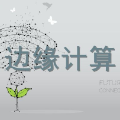Recent advancements in technology now allow for the generation of massive quantities of data. There is a growing need to transmit this data faster and more securely such that it cannot be accessed by malicious individuals. Edge computing has emerged in previous research as a method capable of improving data transmission times and security before the data ends up in the cloud. Edge computing has an impressive transmission speed based on fifth generation (5G) communication which transmits data with low latency and high bandwidth. While edge computing is sufficient to extract important features from the raw data to prevent large amounts of data requiring excessive bandwidth to be transmitted, cloud computing is used for the computational processes required for developing algorithms and modeling the data. Edge computing also improves the quality of the user experience by saving time and integrating quality of life (QoL) features. QoL features are important for the healthcare sector by helping to provide real-time feedback of data produced by healthcare devices back to patients for a faster recovery. Edge computing has better energy efficiency, can reduce the electricity cost, and in turn help people reduce their living expenses. This paper will take a detailed look into edge computing applications around Internet of Things (IoT) devices, smart city infrastructure, and benefits to healthcare.
翻译:近来技术的进步使得现在能够生成大量数据。 越来越需要更快、更安全地传输这些数据,使恶意个人无法获取这些数据。 前期研究中出现了边缘计算,作为在数据最终进入云层之前改进数据传输时间和安全的一种方法。 边缘计算基于第五代(5G)通信的令人印象深刻的传输速度,该通信传输的数据低潜伏和高带宽度。 边缘计算足以从原始数据中提取重要特征,以防止大量数据需要过度带宽传输,云计算用于制定算法和数据建模所需的计算过程。 边缘计算还将通过节省时间和整合生活质量(QoL)特征来提高用户经验的质量。 QoL特征对于保健部门非常重要,因为它有助于向病人提供保健设备产生的数据的实时反馈,以便更快地恢复。 Edge计算可以提高能源效率,降低电费,并反过来帮助人们降低生活费用。 这份论文将详细查看互联网上的边缘计算应用情况, 包括: 信息基础设施(Io) 和智能城市设备(IHIST) 的好处。




